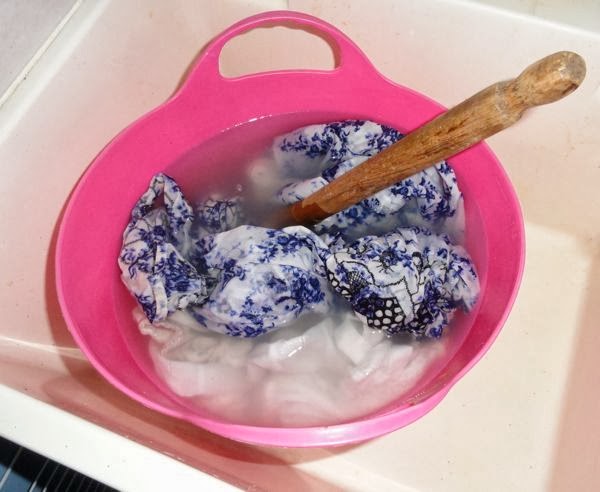I'm often on the lookout for ways to do my day-to-day chores without using any, or very few, cleaning products. There are two clear ways of doing this - for clothes and for dishes. I remember way back in the day when my mum used to soak clothes before washing them. Sometimes she used to put them into a big copper boiler and boil them while moving them around with a wooden stick. The washing took hours to do and often she did it on a Friday night after she finished her outside job. I soak cotton, linen and poly-blend clothes too although I don't do it the way my mum did. If I have something that is badly stained, I fill a large container up with very hot water from the tap, add Disan, an oxy-bleach, dissolve the Disan with my laundry stick and drop the clothes in. BTW, my laundry stick is a spurtle - a scottish stick for stirring porridge. Don't ask why. Almost any fairly new stain can be removed using this method. You can also whiten your greying whites this way as well.
I have two containers I use for soaking. This pink one is about large bucket size - 10 litres/quarts and it easily holds a blouse and a white nightie.
Another way to remove a stain is to wet the fabric and then rub laundry bar soap or laundry liquid on the stain, roll it up and leave it for an hour or so. You roll it up so it doesn't dry out. Then pop it in with the normal wash and the stain will probably go. If you have a top loading washing machine, fill it for your normal wash, apply soap or laundry liquid to any stains you notice, put the stained clothing in the filled washing machine and let it soak, overnight if possible. The following morning, do your normal wash. Generally all stains will be removed by the soaking.
This is my larger 15 litre bucket for towels, sheets and hanno's shirts.
I also soak dishes. We gave away our dishwasher years ago. Quite often I don't wash up our breakfast dishes until after we have lunch. If we've had eggs or baked beans for breakfast, it's the devil's job to remove the egg or tomato sauce from those dishes. Now I'm in the habit of half filling the sink with hot water, with a squirt of dish liquid and letting the dishes soak while I make the lunch. When I empty a pot or frying pan, I pour water in it straight away and let it soak that way. Eventually, when I get to the dishes after lunch, all they need is a quick wipe over and they're clean. A sharp contrast to standing their scrubbing with a brush if I don't pre-soak.
Soaking is one of those gentle, old-fashioned methods you very rarely hear about now because it doesn't use a product that someone is trying to push. This type of clothes care is particularly good for perspiration stains under arms, collar grime, whitening whites and general stains. Soaking works really well and often, if you have a very fresh stain, you can soak without adding any soap or oxy-bleach and it works!


